Aerosols Direct Radiative Effects Combined Ground-Based Lidar and Sun-Photometer Observations: Cases Comparison between Haze and Dust Events in Beijing
Abstract
:1. Introduction
2. Data and Methods
2.1. Site
2.2. Aerosol Optical Data
2.2.1. Columnar Data
2.2.2. Vertical Data
2.3. Meteorological Data
2.4. Radiative Transfer Model
2.5. Backward Trajectory Analysis
3. Results
3.1. Selection of Pollution Episodes
3.2. Vertical Meteorological Conditions
3.3. Aerosol Optical Properties
3.4. Aerosol Shortwave Radiative Effect
4. Conclusions and Discussion
Author Contributions
Funding
Data Availability Statement
Acknowledgments
Conflicts of Interest
References
- Hansen, J.; Sato, M.; Ruedy, R.; Lacis, A.; Oinas, V. Global warming in the twenty-first century: An alternative scenario. Proc. Natl. Acad. Sci. USA 2000, 97, 9875–9880. [Google Scholar] [CrossRef] [Green Version]
- Levy, H.; Schwarzkopf, M.; Horowitz, L.; Ramaswamy, V.; Findell, K.L. Strong sensitivity of late 21st century climate to projected changes in short-lived air pollutants. J. Geophys. Res. Atmos. 2008, 113, D06102. [Google Scholar] [CrossRef] [Green Version]
- Carmichael, G.R.; Adhikary, B.; Kulkarni, S.; D’Allura, A.; Tang, Y.; Streets, D.; Zhang, Q.; Bond, T.C.; Ramanathan, V.; Jamroensan, A.; et al. Asian aerosols: Current and year 2030 distributions and implications to human health and regional climate change. Environ. Sci. Technol. 2009, 43, 5811–5817. [Google Scholar] [CrossRef] [PubMed]
- Lolli, S. Is the Air Too Polluted for Outdoor Activities? Check by Using Your Photovoltaic System as an Air-Quality Monitoring Device. Sensors 2021, 21, 6342. [Google Scholar] [CrossRef] [PubMed]
- Kim, S.; Lee, J.; Oh, S.; Yoon, Y. Assessment of the volcanic hazard of Mt. Paektu explosion to international air traffic using South Korean airspace. Nat. Hazards 2019, 96, 647–667. [Google Scholar] [CrossRef]
- Charlson, R.J.; Schwartz, S.; Hales, J.; Cess, R.D.; Coakley, J., Jr.; Hansen, J.; Hofmann, D. Climate forcing by anthropogenic aerosols. Science 1992, 255, 423–430. [Google Scholar] [CrossRef]
- Che, H.; Qi, B.; Zhao, H.; Xia, X.; Eck, T.F.; Goloub, P.; Dubovik, O.; Estelles, V.; Cuevas-Agulló, E.; Blarel, L.; et al. Aerosol optical properties and direct radiative forcing based on measurements from the China Aerosol Remote Sensing Network (CARSNET) in eastern China. Atmos. Chem. Phys. 2018, 18, 405–425. [Google Scholar] [CrossRef] [Green Version]
- Stocker, T. Climate Change 2013: The Physical Science Basis: Working Group I Contribution to the Fifth Assessment Report of the Intergovernmental Panel on Climate Change; Cambridge University Press: Cambridge, UK, 2014. [Google Scholar]
- Twomey, S.A.; Piepgrass, M.; Wolfe, T. An assessment of the impact of pollution on global cloud albedo. Tellus B 1984, 36, 356–366. [Google Scholar] [CrossRef]
- Rosenfeld, D. Suppression of rain and snow by urban and industrial air pollution. Science 2000, 287, 1793–1796. [Google Scholar] [CrossRef]
- Rosenfeld, D.; Sherwood, S.; Wood, R.; Donner, L. Climate effects of aerosol-cloud interactions. Science 2014, 343, 379–380. [Google Scholar] [CrossRef]
- Yang, Y.; Zheng, Z.; Yim, S.; Roth, M.; Ren, G.; Gao, Z.; Wang, T.; Li, Q.; Shi, C.; Ning, G.; et al. PM2. 5 pollution modulates wintertime urban heat island intensity in the Beijing-Tianjin-Hebei Megalopolis, China. Geophys. Res. Lett. 2020, 47, e2019GL084288. [Google Scholar] [CrossRef] [Green Version]
- Zhao, X.; Zhou, W.; Han, L. Human activities and urban air pollution in Chinese mega city: An insight of ozone weekend effect in Beijing. Phys. Chem. Earth 2019, 110, 109–116. [Google Scholar] [CrossRef]
- An, L.; Che, H.; Xue, M.; Zhang, T.; Wang, H.; Wang, Y.; Zhou, C.; Zhao, H.; Gui, K.; Zheng, Y.; et al. Temporal and spatial variations in sand and dust storm events in East Asia from 2007 to 2016: Relationships with surface conditions and climate change. Sci. Total Environ. 2018, 633, 452–462. [Google Scholar] [CrossRef] [PubMed]
- Wang, W.; Shao, L.; Zhang, D.; Li, Y.; Li, W.; Liu, P.; Xing, J. Mineralogical similarities and differences of dust storm particles at Beijing from deserts in the north and northwest. Sci. Total Environ. 2021, 803, 149980. [Google Scholar] [CrossRef]
- Zhang, R.; Jing, J.; Tao, J.; Hsu, S.-C.; Wang, G.; Cao, J.; Lee, C.S.L.; Zhu, L.; Chen, Z.; Zhao, Y. Chemical characterization and source apportionment of PM2.5 in Beijing: Seasonal perspective. Atmos. Chem. Phys. 2013, 13, 7053–7074. [Google Scholar] [CrossRef] [Green Version]
- Zíková, N.; Wang, Y.; Yang, F.; Li, X.; Tian, M.; Hopke, P.K. On the source contribution to Beijing PM2. 5 concentrations. Atmos. Environ. 2016, 134, 84–95. [Google Scholar] [CrossRef]
- Liu, Q.; Liu, Y.; Yin, J.; Zhang, M.; Zhang, T. Chemical characteristics and source apportionment of PM10 during Asian dust storm and non-dust storm days in Beijing. Atmos. Environ. 2014, 91, 85–94. [Google Scholar] [CrossRef]
- Che, H.; Zhang, X.; Xia, X.; Goloub, P.; Holben, B.; Zhao, H.; Wang, Y.; Zhang, X.; Wang, H.; Blarel, L.; et al. Ground-based aerosol climatology of China: Aerosol optical depths from the China Aerosol Remote Sensing Network (CARSNET) 2002–2013. Atmos. Chem. Phys. 2015, 15, 12715–12776. [Google Scholar] [CrossRef] [Green Version]
- Holben, B.N.; Eck, T.F.; Slutsker, I.; Tanré, D.; Buis, J.P.; Setzer, A.; Vermote, E.; Reagan, J.A.; Kaufman, Y.J.; Nakajima, T. AERONET—A Federated Instrument Network and Data Archive for Aerosol Characterization. Remote Sens. Environ. 1998, 66, 1–16. [Google Scholar] [CrossRef]
- Che, H.; Xia, X.; Zhu, J.; Li, Z.; Dubovik, O.; Holben, B.; Goloub, P.; Chen, H.; Estelles, V.; Cuevas-Agulló, E.; et al. Column aerosol optical properties and aerosol radiative forcing during a serious haze-fog month over North China Plain in 2013 based on ground-based sunphotometer measurements. Atmos. Chem. Phys. 2014, 14, 2125–2138. [Google Scholar] [CrossRef] [Green Version]
- Zheng, Y.; Che, H.; Xia, X.; Wang, Y.; Wang, H.; Wu, Y.; Tao, J.; Zhao, H.; An, L.; Li, L.; et al. Five-year observation of aerosol optical properties and its radiative effects to planetary boundary layer during air pollution episodes in North China: Intercomparison of a plain site and a mountainous site in Beijing. Sci. Total Environ. 2019, 674, 140–158. [Google Scholar] [CrossRef]
- Xia, X.; Wang, P.; Chen, H.; Gouloub, P.; Zhang, W. Ground-based remote sensing of aerosol optical properties over north China in spring. J. Remote Sens. 2005, 9, 429–437. [Google Scholar] [CrossRef] [Green Version]
- Xin, J.; Wang, Y.; Li, Z.; Wang, P.; Hao, W.M.; Nordgren, B.L.; Wang, S.; Liu, G.; Wang, L.; Wen, T.; et al. Aerosol optical depth (AOD) and Ångström exponent of aerosols observed by the Chinese Sun Hazemeter Network from August 2004 to September 2005. J. Geophys. Res. Atmos. 2007, 112, D05203. [Google Scholar] [CrossRef]
- Zhong, J.; Zhang, X.; Wang, Y.; Liu, C.; Dong, Y. Heavy aerosol pollution episodes in winter Beijing enhanced by radiative cooling effects of aerosols. Atmos. Res. 2018, 209, 59–64. [Google Scholar] [CrossRef]
- Xie, C.; Nishizawa, T.; Sugimoto, N.; Matsui, I.; Wang, Z. Characteristics of aerosol optical properties in pollution and Asian dust episodes over Beijing, China. Appl. Optics 2008, 47, 4945–4951. [Google Scholar] [CrossRef]
- Sun, J.; Zhang, Q.; Canagaratna, M.R.; Zhang, Y.; Ng, N.L.; Sun, Y.; Jayne, J.T.; Zhang, X.; Zhang, X.; Worsnop, D.R. Highly time-and size-resolved characterization of submicron aerosol particles in Beijing using an Aerodyne Aerosol Mass Spectrometer. Atmos. Environ. 2010, 44, 131–140. [Google Scholar] [CrossRef]
- Gui, K.; Che, H.; Zheng, Y.; Zhao, H.; Yao, W.; Li, L.; Zhang, L.; Wang, H.; Wang, Y.; Zhang, X. Three-dimensional climatology, trends, and meteorological drivers of global and regional tropospheric type-dependent aerosols: Insights from 13 years (2007–2019) of CALIOP observations. Atmos. Chem. Phys. 2021, 21, 15309–15336. [Google Scholar] [CrossRef]
- Wang, Z.; Liu, C.; Dong, Y.; Hu, Q.; Liu, T.; Zhu, Y.; Xing, C. Profiling of Dust and Urban Haze Mass Concentrations during the 2019 National Day Parade in Beijing by Polarization Raman Lidar. Remote Sens. 2021, 13, 3326. [Google Scholar] [CrossRef]
- Zhang, X.; Zhong, J.; Wang, J.; Wang, Y.; Liu, Y. The interdecadal worsening of weather conditions affecting aerosol pollution in the Beijing area in relation to climate warming. Atmos. Chem. Phys. 2018, 18, 5991–5999. [Google Scholar] [CrossRef] [Green Version]
- Liou, K.-N.; Sasamori, T. On the Transfer of Solar Radiation in Aerosol Atmospheres. J. Atmos. Sci. 1975, 32, 2166–2177. [Google Scholar] [CrossRef] [Green Version]
- Liou, K.-N. An Introduction to Atmospheric Radiation; Elsevier: Amsterdam, The Netherlands, 2002; ISBN 0124514510. [Google Scholar]
- Wu, J.; Jiang, W.; Fu, Z.; Su, B.; Liu, H.; Tang, J. Simulation of the Radiative Effect of Black Carbon Aerosols and the Regional Climate Responses over China. Adv. Atmos. Sci. 2004, 21, 637–649. [Google Scholar] [CrossRef]
- Zhang, H.; Zhou, C.; Wang, Z.; Zhao, S.; Li, J. The influence of different black carbon and sulfate mixing methods on their optical and radiative properties. J. Quant. Spectrosc. Radiat. Transf. 2015, 161, 105–116. [Google Scholar] [CrossRef]
- Bond, T.C.; Doherty, S.J.; Fahey, D.W.; Forster, P.M.; Berntsen, T.; DeAngelo, B.J.; Flanner, M.G.; Ghan, S.; Kärcher, B.; Koch, D.; et al. Bounding the role of black carbon in the climate system: A scientific assessment. J. Geophys. Res. Atmos. 2013, 118, 5380–5552. [Google Scholar] [CrossRef]
- Wang, T.; Han, Y.; Huang, J.; Sun, M.; Jian, B.; Huang, Z.; Yan, H. Climatology of Dust-Forced Radiative Heating over the Tibetan Plateau and Its Surroundings. J. Geophys. Res. Atmos. 2020, 125, 7721641. [Google Scholar] [CrossRef]
- Wang, Y.; Feng, J.; Zheng, Z.; Jin, S. Sensitivity of the Weather Research and Forecasting Model to Radiation Schemes in China. J. Trop. Meteorol. 2019, 25, 201–210. [Google Scholar] [CrossRef]
- Mielikainen, J.; Huang, B.; Huang, H.-L.A.; Goldberg, M.D. GPU acceleration of the updated Goddard shortwave radiation scheme in the weather research and forecasting (WRF) model. J. Sel. Top. App. Remote. Sens. 2012, 5, 555–562. [Google Scholar] [CrossRef]
- Zhong, X.; Ruiz-Arias, J.A.; Kleissl, J. Dissecting surface clear sky irradiance bias in numerical weather prediction: Application and corrections to the New Goddard Shortwave Scheme. Sol. Energy 2016, 132, 103–113. [Google Scholar] [CrossRef]
- Ruiz-Arias, J.A.; Dudhia, J.; Santos-Alamillos, F.J.; Pozo-Vázquez, D. Surface clear-sky shortwave radiative closure intercomparisons in the Weather Research and Forecasting model. J. Geophys. Res. Atmos. 2013, 118, 9901–9913. [Google Scholar] [CrossRef]
- Penner, J.E.; Zhang, S.Y.; Chin, M.; Chuang, C.C.; Feichter, J.; Feng, Y.; Geogdzhayev, I.V.; Ginoux, P.; Herzog, M.; Higurashi, A.; et al. A comparison of model- and satellite-derived aerosol optical depth and reflectivity. J. Atmos. Sci. 2002, 59, 441–460. [Google Scholar] [CrossRef] [Green Version]
- Che, H.; Yang, L.; Liu, C.; Xia, X.; Wang, Y.; Wang, H.; Wang, H.; Lu, X.; Zhang, X. Long-term validation of MODIS C6 and C6. 1 Dark Target aerosol products over China using CARSNET and AERONET. Chemosphere 2019, 236, 124268. [Google Scholar] [CrossRef]
- Han, X.; Zou, X.; Song, Z.; Fu, D.; Xia, X.; Che, H. Comparison of AVHRR aerosol optical depth production against CARSNET data in China. Atmos. Res. 2019, 218, 12–24. [Google Scholar] [CrossRef]
- Eck, T.; Dubovik, O.; Smirnov, A.; Slutsker, I.; Lobert, J. Column-integrated aerosol optical properties over the Maldives during the northeast monsoon for 1998–2000. J. Geophys. Res. Atmos. 2001, 106, 28555–28566. [Google Scholar] [CrossRef]
- Zhang, J.; Christopher, S.A.; Holben, B.N. Intercomparison of smoke aerosol optical thickness derived from GOES 8 imager and ground-based Sun photometers. J. Geophys. Res. Atmos. 2001, 106, 7387–7397. [Google Scholar] [CrossRef] [Green Version]
- Sheng, Z.; Che, H.; Chen, Q.; Liu, D.; Wang, Z.; Zhao, H.; Gui, K.; Zheng, Y.; Sun, T.; Li, X. Aerosol vertical distribution and optical properties of different pollution events in Beijing in autumn 2017. Atmos. Res. 2019, 215, 193–207. [Google Scholar] [CrossRef]
- Cao, N.; Yang, F.; Shi, J.; Wang, F.; Tian, L.; Bu, L. Low altitude fog-haze measurements by Raman-Rayleigh-Mie lidar in Nanjing. J. App. Opt. 2012, 33, 979–984. [Google Scholar] [CrossRef]
- Liu, Q.; He, Q.; Fang, S.; Ying, G.; Ma, C.; Chen, Y.; Kang, Y.; Hu, P.; Zhang, H.; Yao, Y. Vertical distribution of ambient aerosol extinctive properties during haze and haze-free periods based on the Micro-Pulse Lidar observation in Shanghai. Sci. Total Environ. 2016, 574, 1502–1511. [Google Scholar] [CrossRef] [PubMed]
- Zhang, T.; Che, H.; Gong, Z.; Wang, Y.; Wang, J.; Yang, Y.; Gui, K.; Guo, B. The two-way feedback effect between aerosol pollution and planetary boundary layer structure on the explosive rise of PM2.5 after the "Ten Statements of Atmosphere" in Beijing. Sci. Total Environ. 2019, 709, 136259. [Google Scholar] [CrossRef] [PubMed]
- Zhang, T.; Che, H.; Gong, Z.; Wang, Y.; Yang, Y. The dominant mechanism of the explosive rise of PM2.5 after significant pollution emissions reduction in Beijing from 2017 to the COVID-19 pandemic in 2020. Atmos. Pollut. Res. 2020, 12, 272–281. [Google Scholar] [CrossRef]
- Dee, D.; Uppala, S.; Simmons, A.; Berrisford, P.; Poli, P.; Kobayashi, S.; Andrae, U.; Balmaseda, M.; Balsamo, G.; Bauer, P.; et al. The ERA-Interim reanalysis: Configuration and performance of the data assimilation system. Q. J. R. Meteorol. Soc. 2011, 137, 553–597. [Google Scholar] [CrossRef]
- Zhong, J.; Zhang, X.; Wang, Y.; Sun, J.; Zhang, Y.; Wang, J.; Tan, K.; Shen, X.; Che, H.; Zhang, L.; et al. Relative contributions of boundary-layer meteorological factors to the explosive growth of PM2.5 during the red-alert heavy pollution episodes in Beijing in December 2016. J. Meteorol. Res. 2017, 31, 809–819. [Google Scholar] [CrossRef]
- Chou, M.; Suarez, M.J. A Solar Radiation Parameterization (CLIRAD–SW) for Atmospheric Studies; Technical Report NASA/TM 104606; NASA Goddard Space Flight Center: Greenbelt, MD, USA, 1999; Volume 15.
- Wang, H.; Zhang, X.; Gong, S.; Chen, Y.; Shi, G.; Li, W. Radiative feedback of dust aerosols on the East Asian dust storms. J. Geophys. Res. Atmos. 2010, 115, D23214. [Google Scholar] [CrossRef]
- Wang, Y.; Zhang, X.; Arimoto, R. The contribution from distant dust sources to the atmospheric particulate matter loadings at XiAn, China during spring. Sci. Total Environ. 2006, 368, 875–883. [Google Scholar] [CrossRef] [PubMed]
- Liang, Y.; Che, H.; Wang, H. Aerosol Optical Properties and Radiative Effects During a Pollution Episode in Beijing. J. Appl. Meteorol. Sci. 2020, 31, 583–594. [Google Scholar] [CrossRef]
- Zheng, Z.; Zhao, C.; Lolli, S.; Wang, X.; Wang, Y.; Ma, X.; Li, Q.; Yang, Y. Diurnal variation of summer precipitation modulated by air pollution: Observational evidences in the Beijing metropolitan area. Environ. Res. Lett. 2020, 15, 094053. [Google Scholar] [CrossRef]
- Wang, K.; Yin, H.; Chen, Y. The effect of environmental regulation on air quality: A study of new ambient air quality standards in China. J. Clean. Product. 2019, 215, 268–279. [Google Scholar] [CrossRef]
- Tian, S.; Pan, Y.; Wang, Y. Size-resolved source apportionment of particulate matter in urban Beijing during haze and non-haze episodes. Atmos. Chem. Phys. 2016, 16, 1–19. [Google Scholar] [CrossRef] [Green Version]
- Liu, S.; Xing, J.; Sahu, S.; Liu, X.; Liu, S.; Jiang, Y.; Zhang, H.; Li, S.; Ding, D.; Chang, X. Wind-blown dust and its impacts on particulate matter pollution in Northern China: Current and future scenarios. Environ. Res. Lett. 2021, 16, 114041. [Google Scholar] [CrossRef]
- Zhang, X.; Wang, J.; Wang, Y.; Liu, H.; Sun, J.; Zhang, Y. Changes in chemical components of aerosol particles in different haze regions in China from 2006 to 2013 and contribution of meteorological factors. Atmos. Chem. Phys. 2015, 15, 12935–12952. [Google Scholar] [CrossRef] [Green Version]
- Pan, X.; Yan, P.; Tang, J.; Ma, J.; Wang, Z.; Gbaguidi, A.; Sun, Y. Observational study of influence of aerosol hygroscopic growth on scattering coefficient over rural area near Beijing mega-city. Atmos. Chem. Phys. 2009, 9, 7519–7530. [Google Scholar] [CrossRef] [Green Version]
- Che, H.; Xia, X.; Zhu, J.; Wang, H.; Wang, Y.; Sun, J.; Zhang, X.; Shi, G. Aerosol optical properties under the condition of heavy haze over an urban site of Beijing, China. Environ. Sci. Pollut. Res. 2015, 22, 1043–1053. [Google Scholar] [CrossRef]
- Zhang, G.; Ma, Y. Clear-Sky Surface Solar Radiation and the Radiative Effect of Aerosol and Water Vapor Based on Simulations and Satellite Observations over Northern China. Remote Sens. Environ. 2020, 12, 1931. [Google Scholar] [CrossRef]
- Dubovik, O.; Holben, B.N.; Eck, T.F.; Smirnov, A.; Slutsker, I. Variability of Absorption and Optical Properties of Key Aerosol Types Observed in Worldwide Locations. J. Atmos. Sci. 2002, 59, 590–608. [Google Scholar] [CrossRef]
- Sun, T.; Che, H.; Qi, B.; Wang, Y.; Dong, Y.; Xia, X.; Wang, H.; Gui, K.; Zheng, Y.; Zhao, H. Aerosol optical characteristics and their vertical distributions under enhanced haze pollution events: Effect of the regional transport of different aerosol types over eastern China. Atmos. Chem. Phys. 2018, 18, 2949–2971. [Google Scholar] [CrossRef] [Green Version]
- Huang, J.; Wang, T.; Wang, W.; Li, Z.; Yan, H. Climate effects of dust aerosols over East Asian arid and semiarid regions. J. Geophys. Res. Atmos. 2014, 119, 398–416. [Google Scholar] [CrossRef]
- Liou, K.N.; Freeman, K.P.; Sasamori, T. Cloud and aerosol effects on the solar heating rate of the atmosphere. Tellus B 1978, 30, 62–70. [Google Scholar] [CrossRef] [Green Version]
- Haywood, J.; Francis, P.; Osborne, S.; Glew, M.; Loeb, N.; Highwood, E.; Tanré, D.; Myhre, G.; Formenti, P.; Hirst, E. Radiative properties and direct radiative effect of Saharan dust measured by the C-130 aircraft during SHADE: 1. Solar spectrum. J. Geophys. Res. Atmos. 2003, 108, 8. [Google Scholar] [CrossRef] [Green Version]



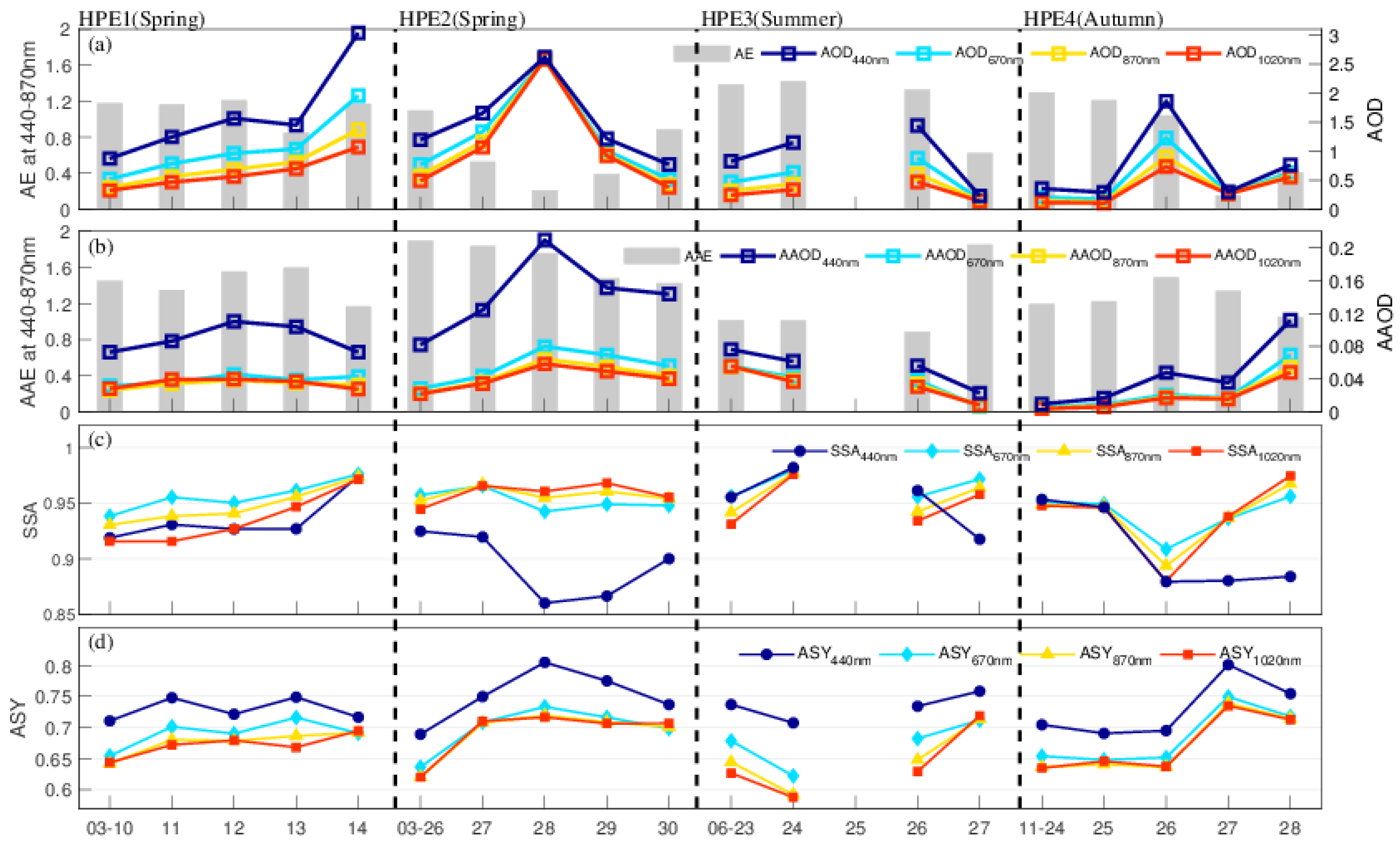

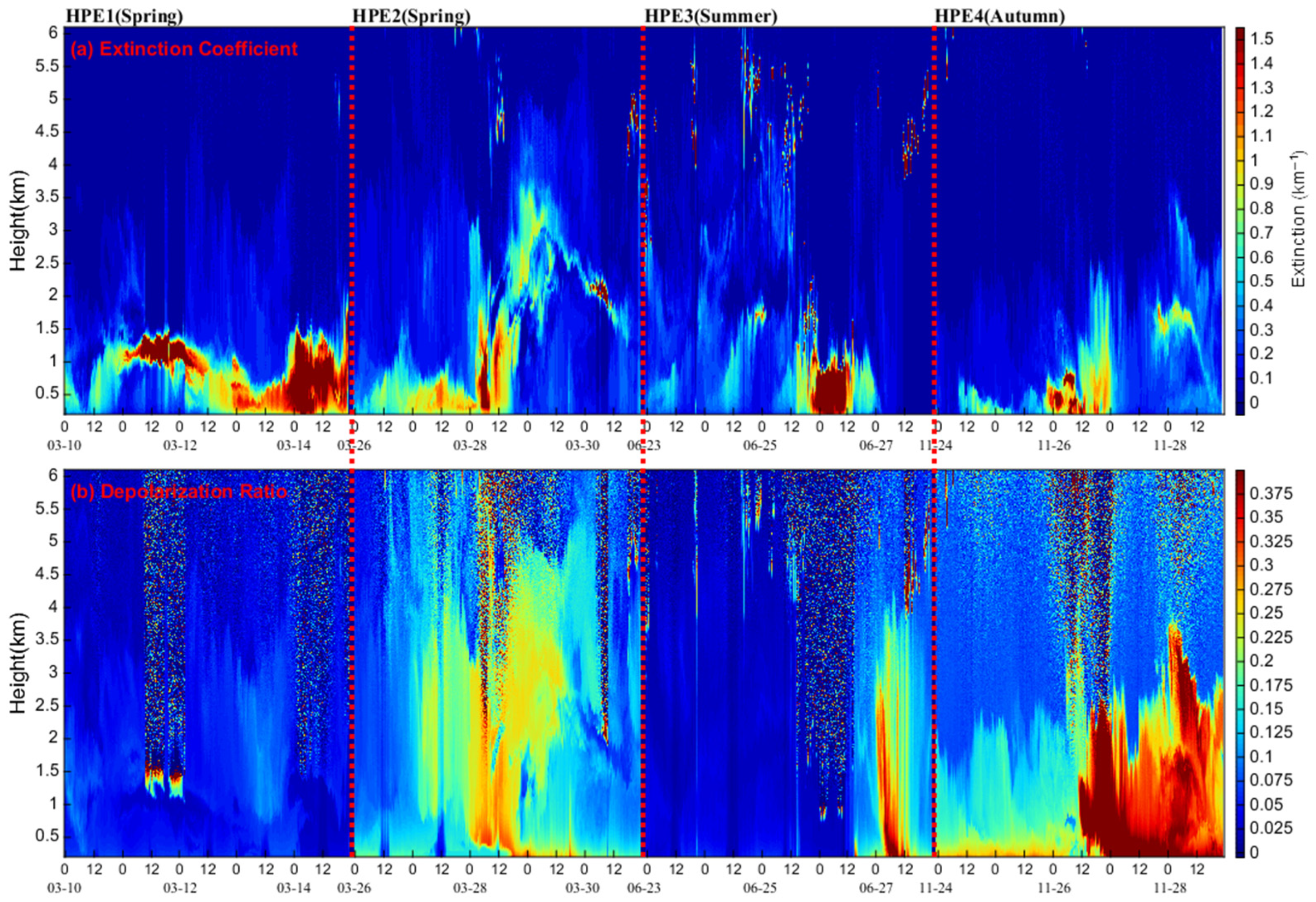
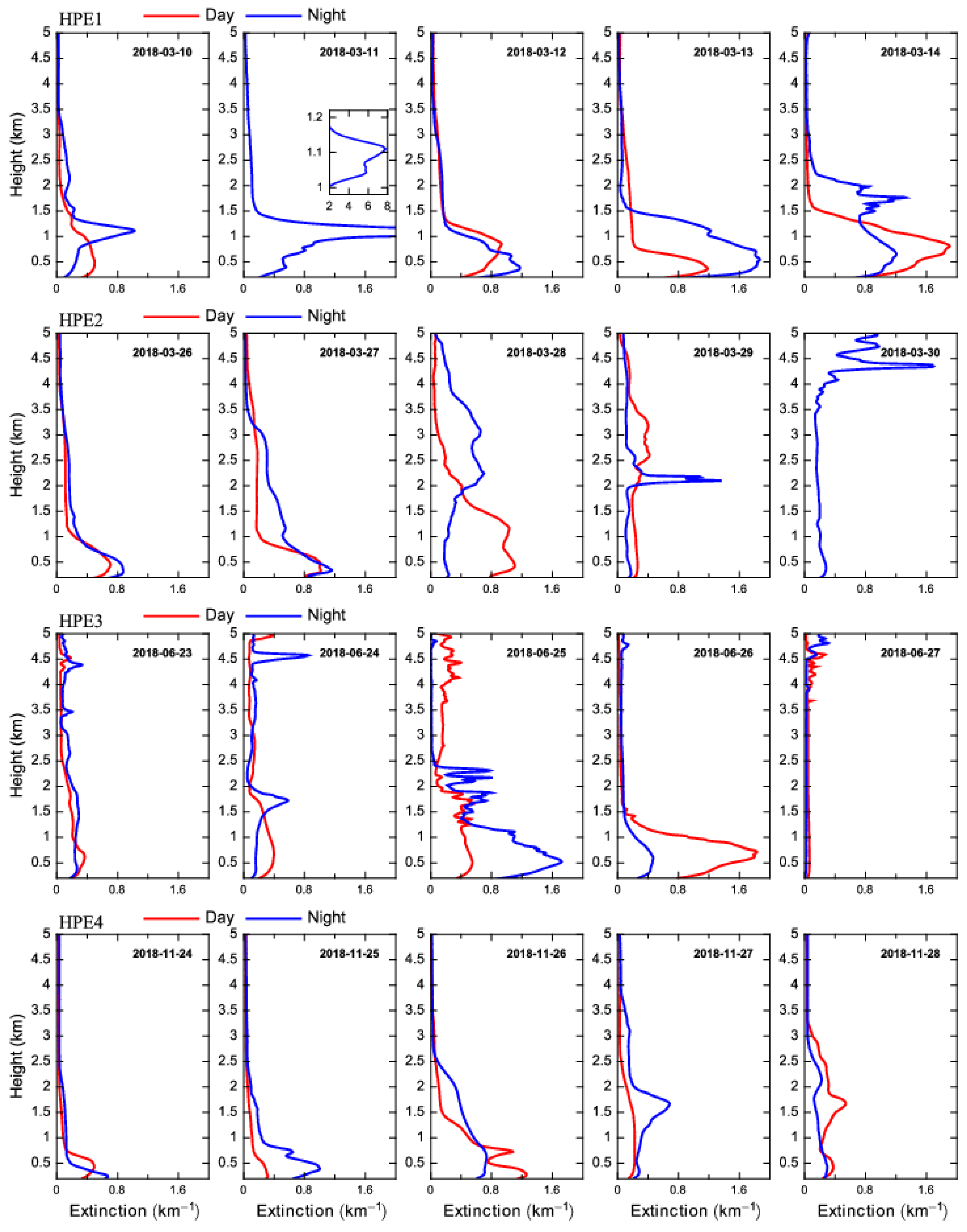
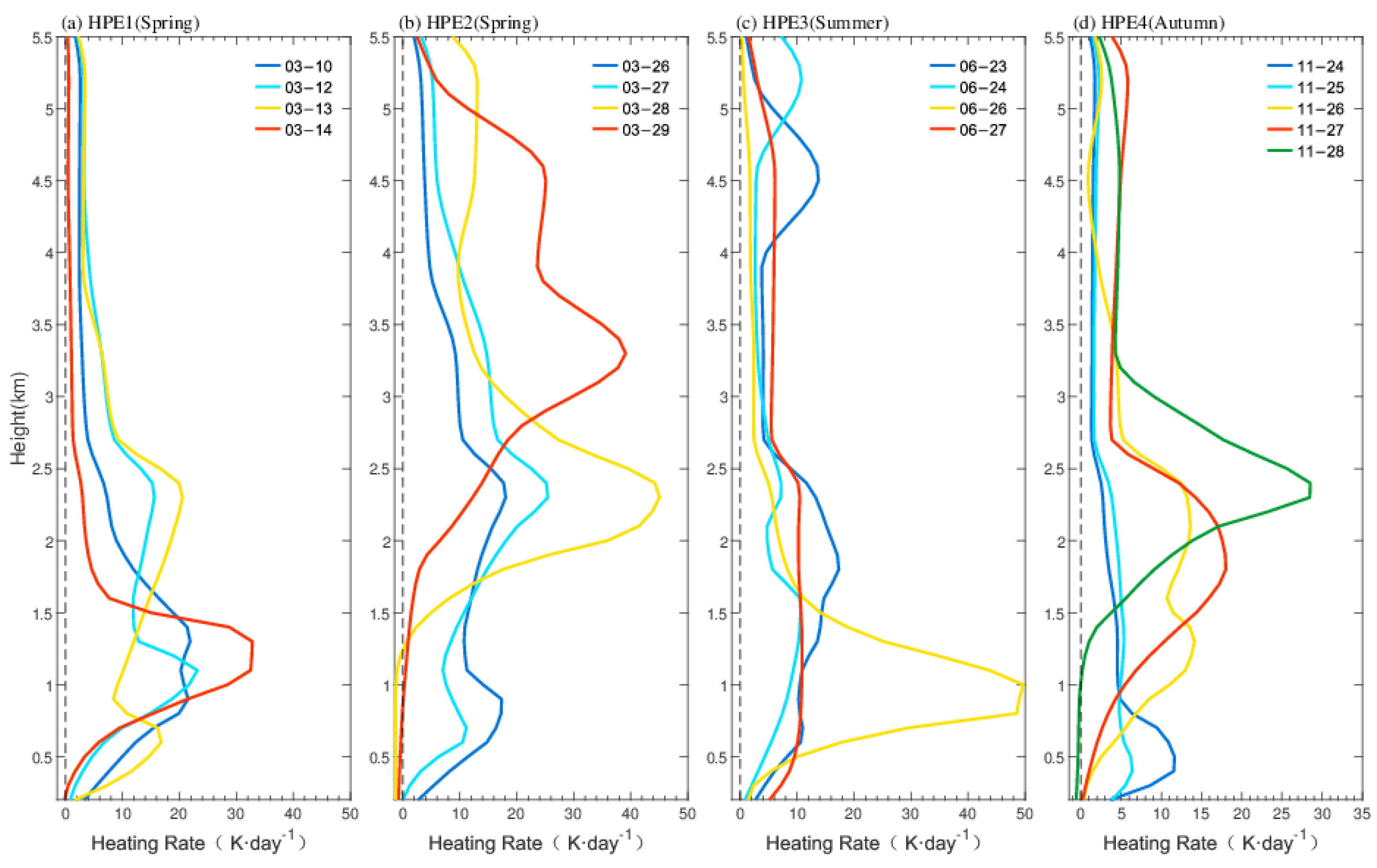
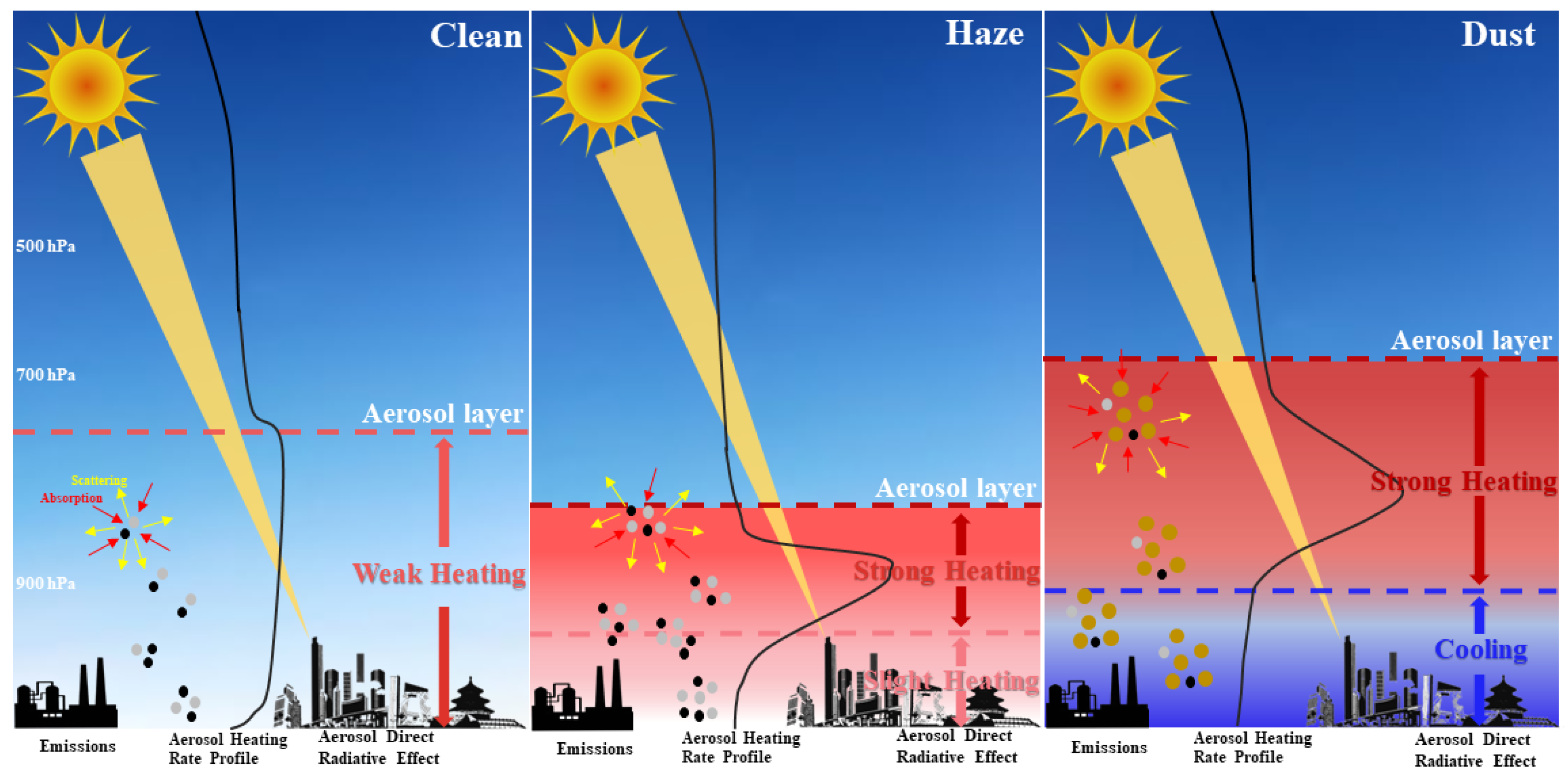
| Solar Wavelength (μm) | Application Wavelength (μm) | |
|---|---|---|
| 1 | (0.175–0.225] | 0.225 |
| 2 | (0.225–0.245] | 0.245 |
| 3 | (0.245–0.260] | 0.260 |
| 4 | (0.280–0.295] | 0.295 |
| 5 | (0.295–0.310] | 0.310 |
| 6 | (0.310–0.320] | 0.320 |
| 7 | (0.320–0.400] | 0.400 |
| 8 | (0.400–0.700] | 0.532 |
| 9 | (0.700–1.220] | 1.220 |
| 10 | (1.220–2.270] | 2.270 |
| 11 | (2.270–10.000] | 5.000 |
| Case (Type) | Date | Mean PM2.5 (μg m−3) | Max PM2.5 (μg m−3) | Mean PM10 (μg m−3) | Max PM10 (μg m−3) | Ratio (PM2.5/ PM10) | General Characteristics |
|---|---|---|---|---|---|---|---|
| HPE1 (Haze) | Mar-10 | 122.08 | 170 | 134.52 | 191 | 0.91 | Moderately polluted |
| Mar-11 | 62.58 | 97 | 77.87 | 125 | 0.80 | Lightly polluted | |
| Mar-12 | 137.50 | 213 | 150.42 | 253 | 0.91 | Moderately polluted | |
| Mar-13 | 255.38 | 302 | / | / | / | Heavily polluted | |
| Mar-14 | 226.82 | 370 | / | / | / | Heavily polluted | |
| HPE2 (Dust) | Mar-26 | 121.88 | 173 | 152.26 | 203 | 0.80 | Moderately polluted |
| Mar-27 | 193.08 | 245 | 225.06 | 273 | 0.86 | Heavily polluted | |
| Mar-28 | 140.75 | 202 | 1001.10 | 2273 | 0.14 | Heavily polluted | |
| Mar-29 | 35.67 | 43 | 177.96 | 291 | 0.20 | Lightly polluted | |
| Mar-30 | 35.63 | 72 | 76.71 | 116 | 0.46 | Clean | |
| HPE3 (Haze) | Jun-23 | 56.88 | 69 | 92.86 | 138 | 0.61 | Clean or Lightly polluted |
| Jun-24 | 52.25 | 69 | 94.29 | 121 | 0.55 | Clean or Lightly polluted | |
| Jun-25 | 77.71 | 149 | 124.82 | 154 | 0.62 | Lightly polluted | |
| Jun-26 | 129.17 | 191 | / | / | / | Moderately polluted | |
| Jun-27 | 26.65 | 63 | 50.82 | 113 | 0.53 | Clean | |
| HPE4 (Mixed) | Nov-24 | 103.04 | 174 | 128.86 | 188 | 0.80 | Lightly polluted |
| Nov-25 | 103.68 | 171 | 119.35 | 185 | 0.87 | Lightly polluted | |
| Nov-26 | 224.52 | 306 | / | / | / | Heavily polluted | |
| Nov-27 | 64.08 | 170 | 277.96 | 834 | 0.23 | Moderately polluted | |
| Nov-28 | 63.29 | 86 | 181.43 | 231 | 0.35 | Lightly polluted |
Publisher’s Note: MDPI stays neutral with regard to jurisdictional claims in published maps and institutional affiliations. |
© 2022 by the authors. Licensee MDPI, Basel, Switzerland. This article is an open access article distributed under the terms and conditions of the Creative Commons Attribution (CC BY) license (https://creativecommons.org/licenses/by/4.0/).
Share and Cite
Liang, Y.; Che, H.; Wang, H.; Zhang, W.; Li, L.; Zheng, Y.; Gui, K.; Zhang, P.; Zhang, X. Aerosols Direct Radiative Effects Combined Ground-Based Lidar and Sun-Photometer Observations: Cases Comparison between Haze and Dust Events in Beijing. Remote Sens. 2022, 14, 266. https://doi.org/10.3390/rs14020266
Liang Y, Che H, Wang H, Zhang W, Li L, Zheng Y, Gui K, Zhang P, Zhang X. Aerosols Direct Radiative Effects Combined Ground-Based Lidar and Sun-Photometer Observations: Cases Comparison between Haze and Dust Events in Beijing. Remote Sensing. 2022; 14(2):266. https://doi.org/10.3390/rs14020266
Chicago/Turabian StyleLiang, Yuanxin, Huizheng Che, Hong Wang, Wenjie Zhang, Lei Li, Yu Zheng, Ke Gui, Peng Zhang, and Xiaoye Zhang. 2022. "Aerosols Direct Radiative Effects Combined Ground-Based Lidar and Sun-Photometer Observations: Cases Comparison between Haze and Dust Events in Beijing" Remote Sensing 14, no. 2: 266. https://doi.org/10.3390/rs14020266
APA StyleLiang, Y., Che, H., Wang, H., Zhang, W., Li, L., Zheng, Y., Gui, K., Zhang, P., & Zhang, X. (2022). Aerosols Direct Radiative Effects Combined Ground-Based Lidar and Sun-Photometer Observations: Cases Comparison between Haze and Dust Events in Beijing. Remote Sensing, 14(2), 266. https://doi.org/10.3390/rs14020266








